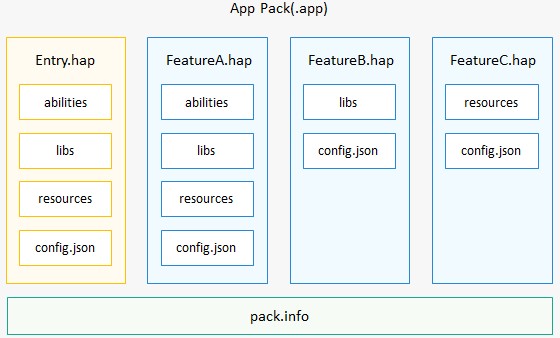https://harmonyos.51cto.com/#zz
4.1 开发完第一个鸿蒙应用后,下面在了解一下完整的鸿蒙应用打包发布后应该是什么样子:
一个完整的打包后应用结构如下图所示,这里我们先了解结构,具体怎么打包很简单只要前提是要签名!

1. HAP的分类
HAP又可分为entry和feature两种模块类型:
1)entry:应用的主模块。一个APP中,对于同一设备类型必须有且只有一个entry类型的HAP,可独立安装运行。
2) feature:应用的动态特性模块。一个APP可以包含一个或多个feature类型的HAP,也可以不含。
2. HAP的组成
HAP是由代码(Ability)、第三方库、资源以及应用配置文件构成,只有包含Ability的HAP才能够独立运行。
1)Ability
Ability是应用所具备的能力的抽象,一个应用可以包含一个或多个Ability。Ability分为两种类型:FA(Feature Ability)和PA(Particle Ability)。FA/PA是应用的基本组成单元,能够实现特定的业务功能。FA有UI界面,而PA无UI界面。
2)库文件
库文件是应用依赖的第三方代码形式,存放在libs目录。
3)资源文件
应用的资源文件(字符串、图片、音频等)存放于resources目录下
4)配置文件
配置文件 (config.json) 是应用的Ability信息,用于声明应用的Ability,以及应用所需权限等信息
3. pack.info文件
描述应用软件包中每个HAP的属性,由IDE编译生成,应用市场根据该文件进行拆包和HAP的分类存储。
HAP的具体属性包括:
1)delivery-with-install: 表示该HAP是否支持随应用安装。
2)name:HAP文件名。
3)module-type:模块类型,entry或feature。
4)device-type:表示支持该HAP运行的设备类型。
4.2 config.json详细细节
1. 应用的每个HAP的根目录下都存在一个“config.json”配置文件,主要涵盖以下三个方面:
1)应用的全局配置信息,包含应用的包名、生产厂商、版本号等基本信息。
2)应用在具体设备上的配置信息。
3)HAP包的配置信息,包含每个Ability必须定义的基本属性(如包名、类名、类型以及Ability提供的能力),以及应用访问系统或其他应用受保护部分所需的权限等。
2. config.json配置文件的内部结构
应用的配置文件“config.json”中由“app”、“deviceConfig”和“module”三个部分组成,缺一不可。
3. “config.json”文件约定
配置文件“config.json”采用JSON文件格式,由属性和值两部分构成:
1)属性:属性出现顺序不分先后,且每个属性最多只允许出现一次。
2)值:每个属性的值为JSON的基本数据类型(数值、字符串、布尔值、数组、对象或者null类型)。
学习建议:根据官方文档自己做一个思维导图,做的过程中熟悉,用的时候查询,我学习的时候做的,附件在后面,需要一个叫MindMaster的思维导图工具打开。做完思维导图系统地熟悉一遍这个配置项后,再在下面的练习中,把每个配置项目的意思备注后面,加深印象。
练习1:认一遍app部分,把说明注释在第一个例子的app配置后面:
- "app": { //表示应用的全局配置信息,就像这样,后面的自己做......
- "bundleName": "com.example.myapplication",
- "vendor": "example",
- "version": {
- "code": 1,
- "name": "1.0"
- },
- "apiVersion": {
- "compatible": 3,
- "target": 3
- }
- },
练习2:认一遍deviceConfig部分,把说明注释在后面:
- "deviceConfig": {//表示应用在具体设备上的配置信息。
- "default": {
- "process": "com.huawei.hiworld.example",
- "directLaunch": false,
- "supportBackup": false,
- "network": {
- "usesCleartext": true,
- "securityConfig": {
- "domainSettings": {
- "cleartextPermitted": true,
- "domains": [
- {
- "subDomains": true,
- "name": "example.ohos.com"
- }
- ]
- }
- }
- }
- }
- }
练习3:认一遍认一下module部分,把说明注释在后面:
- "module": {//表示HAP包的配置信息。该标签下的配置只对当前HAP包生效。
- "package": "com.example.myapplication",
- "name": ".MyApplication",
- "reqCapabilities": [
- "video_support"
- ],
- "deviceType": [
- "tv"
- ],
- "distro": {
- "deliveryWithInstall": true,
- "moduleName": "entry",
- "moduleType": "entry"
- },
- "abilities": [
- {
- "skills": [
- {
- "entities": [
- "entity.system.home"
- ],
- "actions": [
- "action.system.home"
- ]
- }
- ],
- "orientation": "landscape",
- "formEnabled": false,
- "name": "com.example.myapplication.MainAbility",
- "icon": "$media:icon",
- "description": "$string:mainability_description",
- "label": "MyApplication",
- "type": "page",
- "launchType": "standard"
- },
- {
- "orientation": "landscape",
- "formEnabled": false,
- "name": "com.example.myapplication.Secondbility",
- "icon": "$media:icon",
- "description": "$string:secondbility_description",
- "label": "entry",
- "type": "page",
- "launchType": "standard"
- }
- ]
- }
4.3 进一步了解资源目录的细节
1. 资源文件的知识点
应用的资源文件都在resources目录下,resources子目录分两大类目录:具体的知识点,同样我们做成思维导图,见后面附件。
2. 资源文件的使用
base目录与限定词目录中的资源文件:通过指定资源类型(type)和资源名称(name)来引用。
1)Java文件引用资源文件的格式:
(1)普通资源:ResourceTable.type_name。
(2)系统资源,则采用:ohos.global.systemres.ResourceTable.type_name。
(3)目前支持的系统资源文件:
① ic_app:表示HarmonyOS应用的默认图标,类型为媒体。
② request_location_reminder_title:表示“请求使用设备定位功能”的提示标题,类型为字符串。
③ request_location_reminder_content:表示“请求使用设备定位功能”的提示内容,类型为字符串。
示例一:在Java文件中,引用系统资源。
- ResourceManager rsManager = this.getResourceManager();
- try {
- String str = rsManager
- .getElement(ohos.global.systemres.ResourceTable.
- String_request_location_reminder_title).getString();
- Text text = (Text) findComponentById(ResourceTable.Id_text);
- text.setText(str);
- } catch (Exception e) {
- terminateAbility();
- }
示例二:在Java文件中,引用string.json文件中类型为“String”、名称为“app_name”的资源。
string.json的例子:
- {
- "color":[
- {
- "name":"red",
- "value":"#ff0000"
- },
- {
- "name":"red_ref",
- "value":"$color:red"
- }
- ]
- }
- ohos.global.resource.ResourceManager resManager = getResourceManager();
- int color = resManager.getElement(ResourceTable.Color_red).getColor();
示例四:在Java文件中,获取profile中的文件内容。
- Resource resource = null;
- try {
- Text text = (Text) findComponentById(ResourceTable.Id_text);
- resource = getResourceManager().getResource(ResourceTable.Profile_test1);
- InputStreamReader inputStreamReader = new InputStreamReader(resource, "utf-8");
- BufferedReader bufferedReader = new BufferedReader(inputStreamReader);
- String lineTxt = "";
- while((lineTxt = bufferedReader.readLine()) != null){
- text.append(","+lineText);
- }
- } catch (Exception e) {
- }
2)XML文件引用资源文件的格式:
(1)普通资源,$type:name
(2)系统资源,则采用:$ohos:type:name。
在XML文件中,引用 string.json文件中类型为“String”、名称为“app_name”的资源,示例如下:
- <?xml version="1.0" encoding="utf-8"?>
- <DirectionalLayout xmlns:ohos="http://schemas.huawei.com/res/ohos"
- ohos:width="match_parent"
- ohos:height="match_parent"
- ohos:orientation="vertical">
- <Text ohos:text="$string:app_name"/>
- </DirectionalLayout>
9. rawfile目录中的资源文件
通过指定文件路径和文件名称来引用。
在Java文件中,引用一个路径为“resources/rawfile/”、名称为“ttt.txt”的资源文件,示例如下:
- Resource resource = null;
- try {
- Text text = (Text) findComponentById(ResourceTable.Id_text);
- resource = getResourceManager().getRawFileEntry("resources/rawfile/ttt.txt").openRawFile();
- InputStreamReader inputStreamReader = new InputStreamReader(resource, "utf-8");
- BufferedReader bufferedReader = new BufferedReader(inputStreamReader);
- String lineTxt = "";
- while((lineTxt = bufferedReader.readLine()) != null){
- text.append(","+lineTxt );
- }
- } catch (Exception e) {
- }
文章配套视频课程《鸿蒙手机应用开发入门》https://edu.51cto.com/course/26133.html
©著作权归作者和HarmonyOS技术社区共同所有,如需转载,请注明出处,否则将追究法律责任
https://harmonyos.51cto.com/#zz





























